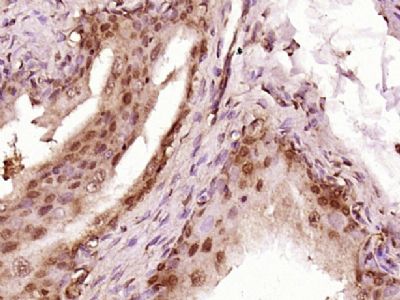The protein encoded by this gene is a member of the superfamily of ATP-binding cassette (ABC) transporters. ABC proteins transport various molecules across extra- and intra-cellular membranes. ABC genes are divided into seven distinct subfamilies (ABC1, MDR/TAP, MRP, ALD, OABP, GCN20, White). This protein is a member of the GCN20 subfamily. Unlike other members of the superfamily, this protein lacks the transmembrane domains which are characteristic of most ABC transporters. This protein may be regulated by tumor necrosis factor-alpha and play a role in enhancement of protein synthesis and the inflammation process. [provided by RefSeq, Jul 2008]
Function:
Isoform 2 is required for efficient Cap- and IRES-mediated mRNA translation initiation. Isoform 2 is not involved in the ribosome biogenesis.
Subunit:
Isoform 2 interacts (via N-terminus) with EIF2S1; the interaction is independent of its phosphorylated status. Isoform 2 associates (via both ABC transporter domains) with the ribosomes.
Subcellular Location:
Isoform 2: Cytoplasm. Nucleus, nucleoplasm. Nucleus envelope.
Tissue Specificity:
Ubiquitous.
Post-translational modifications:
Isoform 2 is phosphorylated at phosphoserine and phosphothreonine. Isoform 2 phosphorylation on Ser-109 and Ser-140 by CK2; inhibits association of EIF2 with ribosomes. Phosphorylated upon DNA damage, probably by ATM or ATR.
Similarity:
Belongs to the ABC transporter superfamily. ABCF family. EF3 subfamily.
Contains 2 ABC transporter domains.
SWISS:
Q8NE71
Gene ID:
23
Database links:
Entrez Gene: 23 Human
Entrez Gene: 224742 Mouse
Entrez Gene: 100144452 Pig
Omim: 603429 Human
SwissProt: Q8NE71 Human
SwissProt: Q6P542 Mouse
SwissProt: Q767L0 Pig
Unigene: 655285 Human
Unigene: 329022 Mouse
| Picture |
Paraformaldehyde-fixed, paraffin embedded (Rat bladder); Antigen retrieval by boiling in sodium citrate buffer (pH6.0) for 15min; Block endogenous peroxidase by 3% hydrogen peroxide for 20 minutes; Blocking buffer (normal goat serum) at 37°C for 30min; Antibody incubation with (ABCF1) Polyclonal Antibody, Unconjugated (SL1960R) at 1:400 overnight at 4°C, followed by a conjugated secondary antibody (sp-0023) for 20 minutes and DAB staining.
|
|
|
